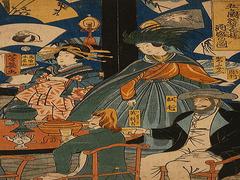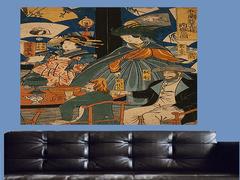The 19th century marked a period of profound cultural exchange between Japan and the West. At the heart of this exchange were Japanese woodblock prints, captivating works that transcended geographical boundaries to influence Western art and culture. This article explores the transformative journey of Japanese woodblock prints from their origins in Edo-period Japan to their enduring impact on the artistic movements and creative minds of the Western world.
Discovery and Fascination
During the 19th century, Japan emerged from centuries of isolation and began engaging with the outside world. As Western nations encountered Japanese culture, woodblock prints, known as ukiyo-e, became an instant fascination. The vibrant colors, dynamic compositions, and unique perspectives captured the imagination of artists, collectors, and connoisseurs alike.
Japonisme: A New Aesthetic
The impact of Japanese woodblock prints on Western art gave rise to the Japonisme movement, characterized by the integration of Japanese artistic elements into Western works. Artists such as Vincent van Gogh, Mary Cassatt, and James McNeill Whistler were captivated by the simplicity, asymmetry, and bold design of ukiyo-e prints. This fusion of styles led to the creation of new art forms that harmoniously merged Eastern and Western sensibilities.
Changing Perspectives
Japanese woodblock prints introduced Western artists to innovative compositional techniques and unconventional viewpoints. The flattened perspective and strategic use of negative space in ukiyo-e prints challenged the Western conventions of representation. This newfound perspective liberated artists, allowing them to experiment with fresh ways of depicting their subjects and the environment.
The Influence on Impressionism
One of the most notable impacts of Japanese woodblock prints was on the Impressionist movement. Impressionist artists embraced the use of color, light, and atmosphere to capture the transient qualities of nature and urban life. These themes paralleled the essence of ukiyo-e, resulting in a shared pursuit of depicting the fleeting moments of existence.
Elevating Everyday Life
Japanese woodblock prints also elevated the depiction of everyday life in Western art. Scenes of leisure, cityscapes, and intimate moments gained prominence as artists recognized the significance of capturing the essence of contemporary existence. This shift challenged traditional notions of subject matter and broadened the scope of artistic representation.
Legacy and Enduring Impact
The influence of Japanese woodblock prints extends far beyond the 19th century. Elements of Japonisme continue to shape the visual language of Western art and design. From poster art and graphic design to fashion and interior décor, the principles borrowed from ukiyo-e prints continue to infuse creativity with a touch of the exotic and the unconventional.
Cultural Dialogue
The impact of Japanese woodblock prints on Western art exemplifies the power of cultural dialogue and artistic exchange. The journey of these prints from Edo to the Western world symbolizes the convergence of diverse perspectives, expanding horizons, and the ability of art to transcend borders.
Conclusion
Japanese woodblock prints embarked on a transformative voyage, leaving an indelible mark on the artistic landscape of the Western world. Through the lens of ukiyo-e, artists discovered new ways of seeing, interpreting, and expressing the world around them. This cross-cultural exchange between East and West stands as a testament to the enduring influence of artistic dialogue, enriching the creative tapestry of human history.
- Beyond Ukiyo-e: The Diverse Landscape of Japanese Woodblock Art
- Evolution of Japanese Woodblock Printing: Tracing the Roots of an Artistic Tradition
- From Edo to the World: How Japanese Woodblock Prints Shaped Western Art and Culture
- Japanese Woodblock History
- Masters of the Blade and Block: The Collaborative Artistry of Samurai and Woodblock Printmakers
- Resilience and Reinvention: Japanese Woodblock Printing in the Face of Modernization
- Techniques and Traditions: Unraveling the Intricacies of Japanese Woodblock Printmaking
- The Influence of Nature in Japanese Woodblock Prints: Depicting Seasons and Symbolism
- The Societal Mirror: Reflecting Daily Life in Edo Period Woodblock Prints
- The Woodblock Artisans of Edo: Masters of Craftsmanship and Creativity
- Ukiyo-e Renaissance: Exploring the Golden Age of Japanese Woodblock Prints




